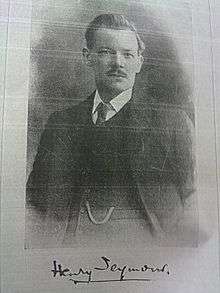Henry Seymour (secularist)
Henry Albert Seymour (1861–1938) was a British secularist, individualist anarchist, gramophone innovator and survey author, and Baconian. He published the first English language anarchist periodical in Britain and is credited, in 1913, with introducing the Edison disc into the country.
Biography

Seymour was born in Hayes, Kent in 1861.
Seymour first came to prominence in 1882, while living in Tunbridge Wells, Kent. Seymour was appointed the secretary of the Tunbridge Wells Secular Society and he was convicted in the summer of 1882 of blasphemy.[1] The events leading to his prosecution involved the publication of a placard advertising a meeting of the society.
In 1885 Seymour published the first English-language individualist anarchist periodical in Britain, The Anarchist. He began work on the first issue while still living in Tunbridge Wells, although it was not published until he completed his move to Islington, London.
The paper was produced from 1885–1888 and was briefly co-edited by Peter Kropotkin and Charlotte Wilson, both of whom went on to form Freedom following disagreements between the three.[2]
As well as producing The Anarchist, Seymour published a wide range of pamphlets and tracts, and he printed handbills for other groups, including the Tunbridge Wells branch of the SDF.[3] The SDF pamphlet was published by the "International Publishing Company", owned by Seymour.
Seymour is important in the history of British anarchism, particularly individualist anarchism a branch of anarchism which has dwindled in influence in Britain since the early 20th century. Seymour published a wide range of works on anarchist subjects. He was involved in the late 19th century radical community in London and it seems likely that Seymour printed material for many individuals and groups.
Seymour was involved in many groups and causes during the latter 1900s. He was a founding member of Free Currency Propaganda[4] and produced a pamphlet called The Monomaniacs – A fable in finance.[5]
Seymour took over editorship of The Adult following the arrest of George Bedborough, the previous editor.[4]
In the early 20th century Seymour became involved in the nascent gramophone industry. He introduced Edison's phonograph to Britain in 1913, and wrote about it in Sound Wave magazine.[6] He wrote The Reproduction of Sound in 1917, described as "acknowledged as the standard work on the subject" in the industry at the time.[7][8] He produced a gramophone called the Superphone and was responsible for many innovations in gramophone technology.
Seymour was key in the development of EMG Gramophones and produced parts for the early production models.[9]
In his later life Seymour became involved in the Francis Bacon Society, and was the editor of the society's journal, Baconiana.[7]
Seymour died on February 3, 1938.[7]
Bibliography
- Seymour, Henry (1888). Michael Bakounine: A Biographical Sketch. London: H. Seymour. p. 8.
- Seymour, Henry (1888). Anarchy: Theory & Practice. London.
- Seymour, Henry (1888). The Anarchy of Love: or the Science of the Sexes. London.
- Seymour, Henry (1889). An Examination of the Malthusian Theory. London.
- Seymour, Henry (1894). The Two Anarchisms. London: Proudhon Press.
- Seymour, Henry (1895). The Monomaniacs: a Fable in Finance (reprinted from London Liberty). London: W. Reeves. p. 8.
- Seymour, Henry (1897). The Fallacy of Marx's Theory of Surplus-Value. London: Murdoch & Co. p. 72.
- Seymour, Henry (1898). The Physiology of Love: a Study in Stirpiculture, etc. London: L.N. Fowler & Co.
- Seymour, Henry (1917). The Reproduction of Sound. Being a description of the mechanical appliances and technical processes employed in the art. London: W B Tattersall.[10][11]
References
- ↑ "04. The Anarchist and Freedom... and Dan Chatterton". libcom.org. Retrieved 2012-01-24.
- ↑ "History » Freedom Press – The Home of Freedom Books and Freedom Newspaper". Freedom Press. 22 February 1999. Retrieved 2012-01-24.
- ↑ "Social Democratic Federation handbill", 1888 image. HenryAlbertSeymour.com.
- 1 2 "The English Individualists As They Appear In Liberty". Uncletaz.com. Retrieved 2012-01-24.
- ↑ "Pamphlets – Henry Albert Seymour blog". Henryalbertseymour.com. 8 July 2011. Retrieved 2012-01-24.
- ↑ Welch, Walter Leslie; Burt, Leah Brodbeck Stenzel; Read, Oliver (1994). From Tinfoil to Stereo: the Acoustic Years of the Recording Industry, 1877–1929. University Press of Florida. p. 118.
- 1 2 3 "Henry Seymour – aet:78". Baconiana, A Periodical Magazine. London: Robert Banks & Son. 23: 55.
- ↑ "The Perfect Gramophone". Gramophone: 27. November 1926.
- ↑ James, Francis (1998). The E.M.G. story. Abertillery: Old Bakehouse. p. . ISBN 978-1-874538-27-1.
- ↑ Bulletin of the Public Library of the City of Boston. 4. Two. Boston Public Library Trustees. 1919. p. 391.
- ↑ Abbate, Carolyn (2001). In Search of Opera. Princeton University Press. p. 277.
External links
- HenryAlbertSeymour.com
- http://www.recordingpioneers.com/RP_SEYMOUR1.html
- Goldman, Falk, Pateman (2003). Emma Goldman: Made for America, 1890–1901. UC Press. p. 556. – Seymour bibliography